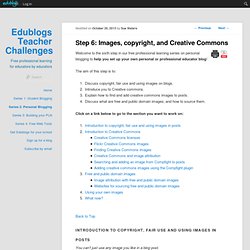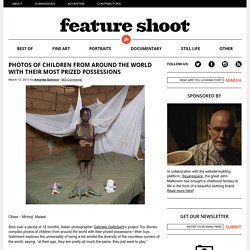

Slic 28-1 Roland Case. • Explain an image: The most widely used line of inquiry is undoubtedly the approach popularly attributed to news reporters to explain the action in an image by asking the 5W’s questions (Who?

Step 6: Images, copyright, and Creative Commons. Welcome to the sixth step in our free professional learning series on personal blogging to help you set up your own personal or professional educator blog!

The aim of this step is to: Discuss copyright, fair use and using images on blogs.Introduce you to Creative commons.Explain how to find and add creative commons images to posts.Discuss what are free and public domain images; and how to source them. Click on a link below to go to the section you want to work on: The Best Online Sources For Images. Check out The “All-Time” Best Sources Of Online Images Jeez, there are sure a ton of ways to find images on the Web, as well as many places where you can find lengthy link lists to image collections.

I’d lay odds that most people, including myself, just use Google Image Search when they need to find an image. However, there might be instances when you want to use another tool — perhaps you’re a language teacher searching for just the right clip art or photography to illustrate a verb, maybe you have very young students and are concerned about what they might find on Google, possibly you’re particularly teaching about copyright issues, or you want your students to easily connect an image to a writing exercise and have them send an E-Card.
(Google has recently added an option in their advanced image search feature — go to the bottom left under “license” and choose “labeled for reuse”) I thought a “The Best…” list might be helpful in one of those, or other particular, instances. The 60 Most Powerful Photos Ever Taken That Perfectly Capture The Human Experience. Stock Photography, Royalty-Free Photos, Videos & Music. Photo of the Month: February, 2014. Teaching with Instagram: 20+ Ideas & Resources. Common Core in Action: 10 Visual Literacy Strategies. Do you wish your students could better understand and critique the images that saturate their waking life?

That's the purpose of visual literacy (VL), to explicitly teach a collection of competencies that will help students think through, think about and think with pictures. Standards Support Visual Literacy Instruction Visual literacy is a staple of 21st century skills, which state that learners must "demonstrate the ability to interpret, recognize, appreciate and understand information presented through visible actions, objects and symbols, natural or man-made. " Putting aside the imperative to teach students how to create meaningful images, the ability to read images is reflected in the following standards. Common Core State Standards (CCSS) CCSS.ELA-Literacy.RH.6-8.7: "Integrate visual information (e.g., in charts, graphs, photographs, videos or maps) with other information in print and digital texts.
" How to Teach Visual Literacy: Visual Thinking Routines. Why Visuals Matter In Storytelling. What's Going On in This Picture? The Most Iconic Images Of Photography. D-Day Invasion, Omaha Beach, Robert Capa, 1944 War photographer Robert Capa prided himself on getting in the thick of the action to capture the most stirring images.
His blurry image of the horrific June 6, 1944 D-Day battle – where the Allies invaded the German-occupied French coast – is a testament to his skill. Bombarded by fighting from all sides, Capa survived the fighting with this image, which perfectly captured the chaos and frenzy of the battle and became one of the most iconic images of photography. Do You Think These People Were Created Equal After Seeing These Photos? Humans, we're a funny bunch.

We're quick to pit people against each other in tribes: liberal vs. conservative, poor vs. rich, old vs. young. But we often seem to overlook the fact that despite these seemingly obvious differences, we all still have the fundamental sameness. Make Your Images Interactive - ThingLink. Welcome to Fotobabble - Talking Photos.
Google Search by Image - A Simple Visual Guide for Teachers and Students. Have you ever tried Google search by image functionality ?

This is a service that allows users to identify potential sources of images on the web. This is a good way for students to pool resources and additional information on images they want to use in their multimedia projects. In content areas like History, Biology, geography...etc search by image is a great way to learn new insights and find out the contexts surrounding the images. For more accurate results, it is recommended that you add some text to the image you are searching for to make it easy for Google search boots to turn in relevant search results. The process of using search by image functionality in Google is pretty simple. A small window will pop up offering the choices of either uploading an image you already have on your computer or using an image URL instead. Camera Angles. Camera angles and movements combine to create a sequence of images, just as words, word order and punctuation combine to make the meaning of a sentence.

You need a straightforward set of key terms to describe them. Describing Shots. Camera Shots. There is a convention in the video, film and television industries which assigns names and guidelines to common types of shots, framing and picture composition.

The list below briefly describes the most common shot types (click the images for more details). Notes: The exact terminology varies between production environments but the basic principles are the same. Shots are usually described in relation to a particular subject. Photos of Children From Around the World With Their Most Prized Possessions. Chiwa – Mchinji, Malawi Shot over a period of 18 months, Italian photographer Gabriele Galimberti‘s project Toy Stories compiles photos of children from around the world with their prized possesions—their toys.

Galimberti explores the universality of being a kid amidst the diversity of the countless corners of the world, saying, “at their age, they are pretty all much the same; they just want to play.” But it’s how they play that seemed to differ from country to country. Galimberti found that children in richer countries were more possessive with their toys and that it took time before they allowed him to play with them (which is what he would do pre-shoot before arranging the toys), whereas in poorer countries he found it much easier to quickly interact, even if there were just two or three toys between them. There were similarites too, especially in the functional and protective powers the toys represented for their proud owners.
French newspaper removes all images in support of photographers. “A visual shock. For the first time in its history, Libération is published without photographs. Coastermatic — Your instagrams in stone, coasters. Make a book. Photo album, picture book, & custom books. Canada's Photo Art Experts.
Canada's Photo Art Experts.